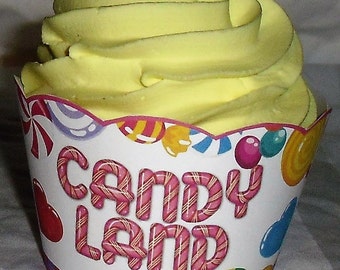
Assuming my children had not lost any, there were 64 cards supplied in our version of the game. I counted the distribution of cards in the game.
CANDY LAND BOARD CUPCAKE COMM CODE
Once done, I could then get code to render the picture: This enabled me to enter the data for the cell colours into an array. Landing on a sticky location, moves the player to this square for their ‘missed turn’, then they move forward on their next round.įirst I created a quick stylised map in Excel (shown on the left) from the game board (shown below). Finally, to represent the sticky locations, there are three additional ‘hidden’ squares 137-139, one behind each sticky location. I modeled the bridges as their own state (when a player is on a bridge, they are on either space 135 or space 136). In addition, there is a space at index zero for the starting location (players start off the board). There are 134 Visible spaces on the board, which can be stored as a simple array. The first player to the last space on the board is the winner.

The rules are not explicit about where/how the player moves on a bridge, but in our house, landing on the bridge places you in limbo on the bridge at the end of that turn, and the turn of your next card on your subsequent move determines your destination past the exit of the bridge. Landing on the start space to one of the two bridges allows the player to take a short cut. Finally, if a player lands on one of the sticky spaces, he misses his next turn. The deck has one pink card for each named location, and drawing such a card moves a player directly to that board location (This move can be either forward or backward). Some cards have two marks of a colour, in which case the player moves his or her marker ahead to the second-next space of that colour. Players alternate in drawing movement cards, most of which show one of six colours, and then moving their token ahead to the next space of that colour. In addition there are six pink spaces containing named characters, two bridges, and three of the coloured spaces are sticky (more of this later). The board consists of a linear track containing 134 spaces, mostly coloured red, green, blue, yellow, orange or purple. A deck of movement cards it shuffled, and players take turns to move their tokens according to the instructions on the card. There is no skill required to play Candyland (other than being able to recognise colours).

This analysis is based on the rules in the version of the game that our family owns!īefore reading this article, if you have not done so already, you might want to read the previous two articles regarding the analysis of Chutes and Ladders and Risk. Over the years, subtle rule changes have been made.

The original game was designed by Eleanor Abbot in 1945. This blog concerns the mathematical analysis of Candyland®, a children’s game produced by Hasbro (before that Milton Bradley).


 0 kommentar(er)
0 kommentar(er)
